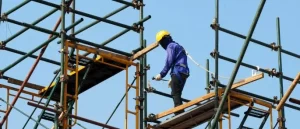Are you struggling to identify hazards? “What are the two hazards in this image, What is the risk, and what PPE can be used to protect workers” for your white card.
Stay tuned.
This article is not about cheating. It is intended to help you develop good judgment in identifying hazards, creating safe work procedures, and motivating workers to wear PPE.

What are the two hazards in this image?
Hazard 1 is working at heights and the risk is falling and causing injury. Hazard 2 is scaffolding which is a risk of scaffold collapse causing injury while working.
How would you report those hazards to the appropriate person on site?
Excuse me, Supervisor. I noticed that a worker on site has started scaffolding while working at heights. They should be wearing a certified safety harness attached to a secure anchor point and a hi-vis vest. We need to do regular safety inspections and ensure everyone follows safety standards. It’s also important to always watch for hazards and keep the work area neat and tidy.
✅ Be Prepared
Giving exactly the same answer won’t always work. Make sure you understand each question and respond in your own words, based on your understanding. If you fail an attempt, call your assessor to find out why — they can explain what you missed and help you improve for next time.
Tip:
A hazard is a situation or thing that can cause harm — not missing PPE. Always identify hazardous situations in images or assessments.
Extra advice:
If you fail an assessment video, calling the assessor can help. They may give you feedback on which hazards you identified correctly, saving you time on future attempts.
Frequently Asked Questions (FAQs)
Q1: What are the two main hazards in the construction image?
A: The two main hazards are working at heights, which poses a risk of falling and injury, and scaffolding, which carries the risk of collapse causing injury while working.
Q2: What PPE is recommended for working at heights and scaffolding?
A: Recommended PPE includes wearing a certified safety harness attached to a secure anchor point and a high-visibility (hi-vis) vest to ensure worker safety on site.
